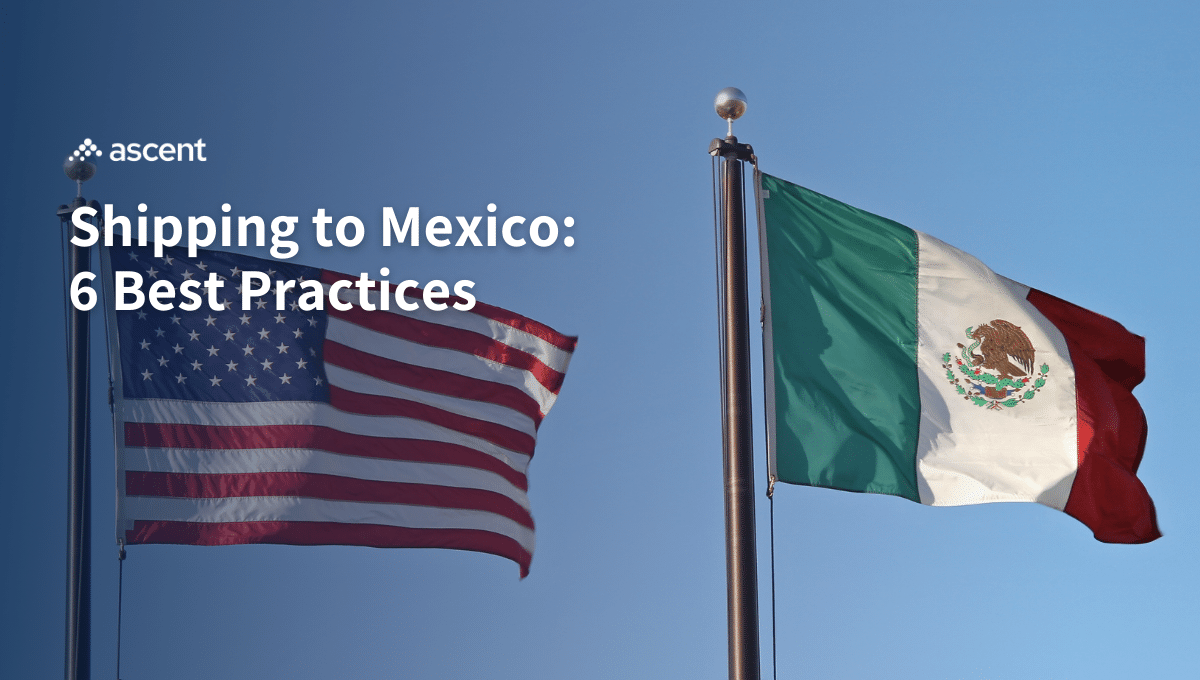Shipping to Mexico from the U.S.: 6 Best Practices
04/30/2024

As the United States’ largest trading partner, Mexico stands at the forefront of international commerce, significantly impacting global trade dynamics. With its growing industrial sector and proximity to the U.S., nearshoring has become a strategic move for U.S. companies looking to optimize supply chains and reduce lead time. As leaders in cross-border logistics, we put together the top six best practices for your business to be successful in shipping to and from the country.
1. Select a Logistics Partner with a Presence in Mexico
Mexico’s set of customs and import/export regulations can be complex and subject to change. A provider with a presence in Mexico will have up-to-date knowledge of these regulations, helping to ensure that shipments comply with local laws, thus avoiding delays, fines or confiscation of goods.
Ascent has provided shipping solutions to and from Mexico for over a decade. With 20+ offices throughout the U.S. and Mexico and 140+ employees in the Latin America region, we’ve been able to leverage regulations and agreements to reduce tariffs and take advantage of preferential treatment for certain goods.
In addition, our robust charter and ground carrier network ensures customers that their shipments will meet local regulations and arrive at their destination on schedule.
2. Cross-Border Shipping: The Importance of Laredo
Laredo, TX, stands as the premier border crossing for trucks in the United States, serving as a vital gateway between the two nations. Adopting cross-docking strategies at the border can help companies consolidate their goods, optimize their transfer process, reduce waiting times, and cut costs.
Implementing cross-docking services for our customers has significantly minimized handling and storage durations, translating to significant cost savings. For urgent needs, we offer premium air and ground solutions in addition to our multimodal direct transportation services, assuring speed and delivery of our customers’ goods.
3. Understand Mexico Customs and Regulatory Compliance
Navigating the complexities of customs and regulatory compliance for cross-border shipping between the U.S. and Mexico requires a proactive and informed approach. Customs brokerage is particularly crucial at the U.S.-Mexico border due to the high volume of trade and the complexity of regulations.
At Ascent, we work with our customers’ customs brokers, helping coordinate necessary information between the carrier, consignee and customs broker to allow for a smoother experience.
4. Diversify Transportation Modes
Diversification of transportation modes is a strategic approach that involves having the flexibility to switch or combine modes of transportation based on real-time logistics needs and challenges. For example, if a labor strike impacts ground transportation routes, having the capability to quickly pivot to an air charter solution can keep the supply chain moving. Similarly, when air freight is not feasible due to shipping costs or volume, utilizing ground options in tandem can offer a balanced solution.
Ascent offers multiple modes of transportation, including air charter, ground expedite, on-board courier, air freight and intra-Mexico truckload. This diversification allows us to optimize speed and find the most cost-effective option for our customers’ needs.
5. Invest in Technology
Leveraging advanced logistics technologies can significantly enhance tracking, forecasting and overall operations management. Integrating these technologies with your systems improves control and visibility across the supply chain.
Ascent customers have access to our proprietary PEAK™ technology, designed to streamline logistics. This technology provides instant access to a premier network of industry carriers and best-in-market rates across all transportation modes. The platform supports all commonly used integration technologies, including API, XML and EDI, ensuring seamless data exchange and communication.
6. Nearshoring is Key
Nearshoring facilitates a more flexible and responsive supply chain model, allowing companies to rapidly increase or decrease production in response to consumer demands. One of the most significant advantages is the substantial reduction in transit times. By relocating manufacturing and distribution centers closer to the U.S. border, companies can dramatically shorten the distance goods need to travel, ensuring faster delivery times to market. This geographic proximity not only speeds up logistics operations but also contributes to lower transportation costs. The shorter the distance, the less fuel and fewer logistics resources are required, leading to considerable savings on shipping internationally.
Monterrey is leading the way in the emerging trend of nearshoring. Numerous businesses from the U.S., Europe and Asia choose this city for its strong infrastructure, network of highways, well-educated workforce, and closeness to the U.S. Monterrey also provides tax breaks and additional benefits, aiding businesses in cutting expenses and boosting their earnings. With investments in the area from businesses like Tesla, Kia and Whirlpool, companies are seeing the benefits from the city’s competitive wages and proficient labor force while remaining close to their operations in the U.S.
Streamline Your Cross-Border Logistics with Ascent
Navigating the complexities of shipping from the U.S. to Mexico can be a daunting task, yet it’s entirely manageable with the right strategies and partnerships in place. With our wealth of experience, time-critical solutions and presence in the country, we’re equipped to help streamline this process for you. Get started today by exploring our cross-border and intra-Mexico shipping solutions.
Navigating Chinese New Year Shipping Delays
December 9, 2024
Thank you for contacting Ascent!
A member of our team will be in contact within a few business hours.
Okay